fuel type Acura TSX 2013 Owner's Manual
[x] Cancel search | Manufacturer: ACURA, Model Year: 2013, Model line: TSX, Model: Acura TSX 2013Pages: 325, PDF Size: 8.61 MB
Page 90 of 325
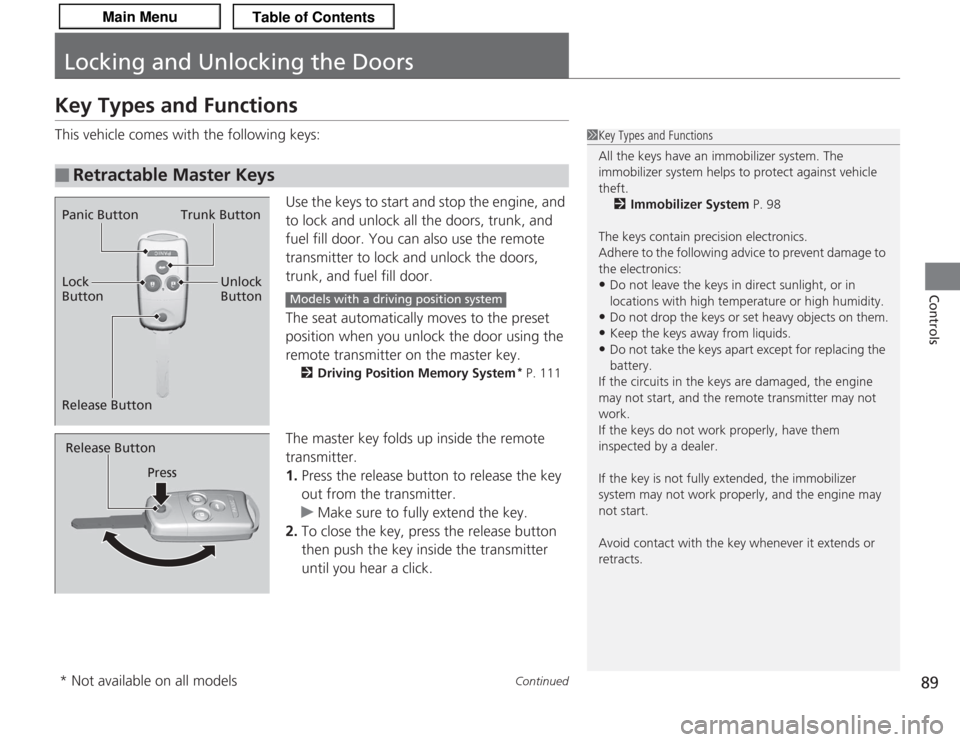
89
Continued
Controls
Locking and Unlocking the DoorsKey Types and FunctionsThis vehicle comes with the following keys:Use the keys to start and stop the engine, and
to lock and unlock all the doors, trunk, and
fuel fill door. You can also use the remote
transmitter to lock and unlock the doors,
trunk, and fuel fill door.
The seat automatically moves to the preset
position when you unlock the door using the
remote transmitter on the master key.
2Driving Position Memory System
* P. 111
The master key folds up inside the remote
transmitter.
1.Press the release button to release the key
out from the transmitter.
u Make sure to fully extend the key.
2. To close the key, press the release button
then push the key inside the transmitter
until you hear a click.
■
Retractable Master Keys
1Key Types and Functions
All the keys have an immobilizer system. The
immobilizer system helps to protect against vehicle
theft.
2 Immobilizer System P. 98
The keys contain precision electronics.
Adhere to the following advice to prevent damage to
the electronics:•Do not leave the keys in direct sunlight, or in
locations with high temperature or high humidity.•Do not drop the keys or set heavy objects on them.•Keep the keys away from liquids.•Do not take the keys apa rt except for replacing the
battery.
If the circuits in the keys are damaged, the engine
may not start, and the re mote transmitter may not
work.
If the keys do not work properly, have them
inspected by a dealer.
If the key is not fully extended, the immobilizer
system may not work properly, and the engine may
not start.
Avoid contact with the key whenever it extends or
retracts.
Panic Button Trunk Button
Lock
Button
Release Button Unlock
Button
Models with a driving position system
Release Button
Press* Not available on all models
Page 223 of 325
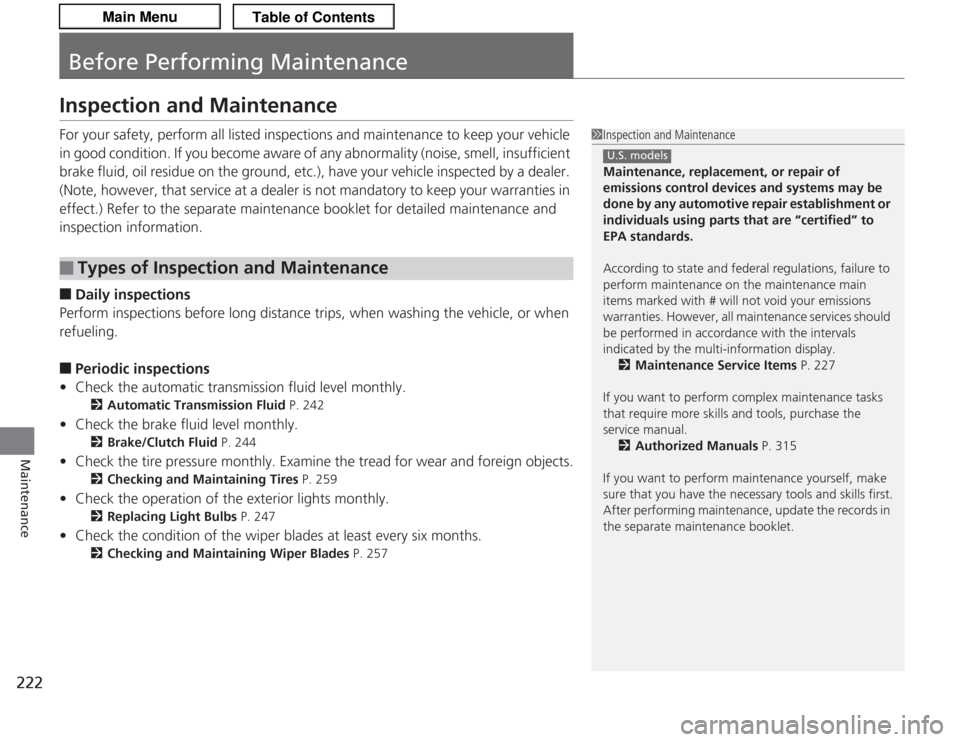
222Maintenance
Before Performing MaintenanceInspection and MaintenanceFor your safety, perform all listed inspections and maintenance to keep your vehicle
in good condition. If you become aware of any abnormality (noise, smell, insufficient
brake fluid, oil residue on the ground, etc.), have your vehicle inspected by a dealer.
(Note, however, that service at a dealer is not mandatory to keep your \
warranties in
effect.) Refer to the separate maintenance booklet for detailed maintenance and
inspection information.■
Daily inspections
Perform inspections before long distance trips, when washing the vehicle, or when
refueling.
■
Periodic inspections
• Check the automatic transmission fluid level monthly.
2 Automatic Transmission Fluid P. 242
•Check the brake fluid level monthly.
2 Brake/Clutch Fluid P. 244
•Check the tire pressure monthly. Examine the tread for wear and foreign objects.
2 Checking and Maintaining Tires P. 259
•Check the operation of the exterior lights monthly.
2 Replacing Light Bulbs P. 247
•Check the condition of the wiper blades at least every six months.
2Checking and Maintaining Wiper Blades P. 257
■
Types of Inspection and Maintenance
1Inspection and Maintenance
Maintenance, replacement, or repair of
emissions control devices and systems may be
done by any automotive repair establishment or
individuals using parts that are “certified” to
EPA standards.
According to state and federal regulations, failure to
perform maintenance on the maintenance main
items marked with # will not void your emissions
warranties. However, all maintenance services should
be performed in accordance with the intervals
indicated by the multi-information display.
2 Maintenance Service Items P. 227
If you want to perform complex maintenance tasks
that require more skills and tools, purchase the
service manual. 2 Authorized Manuals P. 315
If you want to perform maintenance yourself, make
sure that you have the necessary tools and skills first.
After performing maintenance, update the records in
the separate maintenance booklet.
U.S. models
Page 241 of 325

240
uuMaintenance Under the Hood uEngine Coolant
Maintenance
Engine CoolantThis coolant is premixed with 50% antifreeze and 50% water. Do not add any
straight antifreeze or water.
We recommend you check the engine coolant level every time you refuel. Check the
reserve tank first. If it is completely empty, also check the coolant level in the
radiator. Add the engine coolant accordingly.
1.Remove the right-side engine compartment
cover.
2 Engine Compartment Covers P. 233
2.Check the amount of coolant in the reserve
tank.
3. If the coolant level is below the MIN mark,
add the specified coolant until it reaches
the MAX mark.
4. Inspect the cooling system for leaks.
Specified coolant: Honda Long Life Antifreeze/Coolant Type 2■
Reserve Tank
1Engine Coolant
NOTICEIf temperatures consistently below -22°F (-30°C) are
expected, the coolant mixture should be changed to
a higher concentration. Consult a dealer for more
information.
If Honda antifreeze/coolant is not available, you may
use another major brand non-silicate coolant as a
temporary replacement. Check that it is a high quality
coolant recommended for aluminum engines.
Continued use of any non-Honda coolant can result
in corrosion, causing the cooling system to
malfunction or fail. Have the cooling system flushed
and refilled with Honda antifreeze/coolant as soon as
possible.
Do not add rust inhibitors or other additives to your
vehicle’s cooling system. They may not be compatible
with the coolant or with the engine components.4-cylinder models
Reserve Tank
MAX MIN
6-cylinder modelsAll models
Reserve Tank
Page 260 of 325
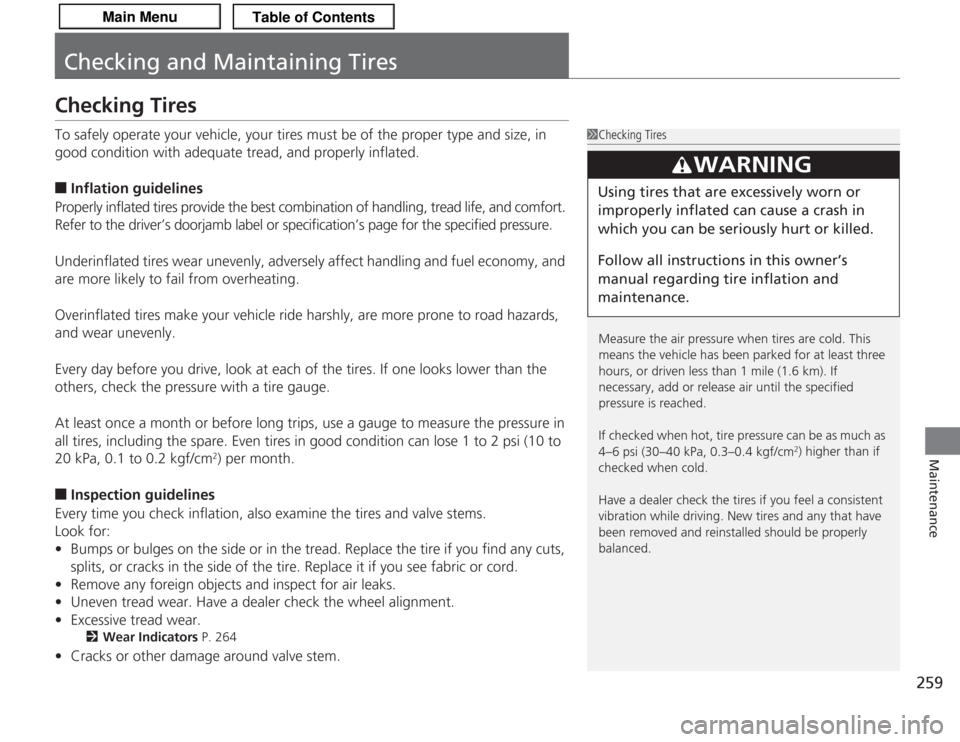
259
Maintenance
Checking and Maintaining TiresChecking TiresTo safely operate your vehicle, your tires must be of the proper type and size, in
good condition with adequate tread, and properly inflated.■
Inflation guidelines
Properly inflated tires provide the best combination of handling, tread life, and comfort.
Refer to the driver’s doorjamb label or specification’s page for the specified pressure.
Underinflated tires wear unevenly, adversely affect handling and fuel economy, and
are more likely to fail from overheating.
Overinflated tires make your vehicle ride harshly, are more prone to road hazards,
and wear unevenly.
Every day before you drive, look at each of the tires. If one looks lower than the
others, check the pressure with a tire gauge.
At least once a month or before long trips, use a gauge to measure the pressure in
all tires, including the spare. Even tires in good condition can lose 1 to 2 psi (10 to
20 kPa, 0.1 to 0.2 kgf/cm
2) per month.
■
Inspection guidelines
Every time you check inflation, also examine the tires and valve stems.
Look for:
• Bumps or bulges on the side or in the tread. Replace the tire if you find any cuts,
splits, or cracks in the side of the tire. Replace it if you see fabric or cord.
• Remove any foreign objects and inspect for air leaks.
• Uneven tread wear. Have a dealer check the wheel alignment.
• Excessive tread wear.
2 Wear Indicators P. 264
•Cracks or other damage around valve stem.
1Checking Tires
Measure the air pressure when tires are cold. This
means the vehicle has been par ked for at least three
hours, or driven less than 1 mile (1.6 km). If
necessary, add or release air until the specified
pressure is reached.
If checked when hot, tire pressure can be as much as
4–6 psi (30–40 kPa, 0.3–0.4 kgf/cm
2) higher than if
checked when cold.
Have a dealer check the tires if you feel a consistent
vibration while driving. New tires and any that have
been removed and reinstalled should be properly
balanced.
3
WARNING
Using tires that are excessively worn or
improperly inflated can cause a crash in
which you can be seri ously hurt or killed.
Follow all instruc tions in this owner’s
manual regarding tire inflation and
maintenance.
Page 276 of 325

275
Handling the Unexpected
This chapter explains how to handle unexpected troubles.
Tools.................................................. 276
Types of Tools .................................. 276
If a Tire Goes Flat .............................. 277
Changing a Flat Tire ......................... 277
Engine Does Not Start Checking the Engine ........................ 283
Jump Starting .................................... 284
Shift Lever Does Not Move .............. 287
Overheating ...................................... 288
How to Handle Overheating ............. 288 Indicator, Coming On/Blinking
If the Low Oil Pressure Indicator Comes
On.................................................. 290If the Charging System Indicator Comes
On ................................................. 290
If the Malfunction Indicator Lamp Comes On or Blinks ................................... 291If the Brake System Indicator Comes On .. 292If the EPS System Indicator Comes On ... 292If the Low Tire Pressure/TPMS Indicator Comes On or Blinks........................ 293 Fuses
Fuse Locations ................................. 294
Circuit Protected and Amps for Each Fuse............................................ 296Inspecting and Changing Fuses ........ 298
Emergency Towing ........................... 299
When You Cannot Unlock the Fuel Fill Door ................................................. 300
When You Cannot Open the Trunk .. 301
Page 305 of 325
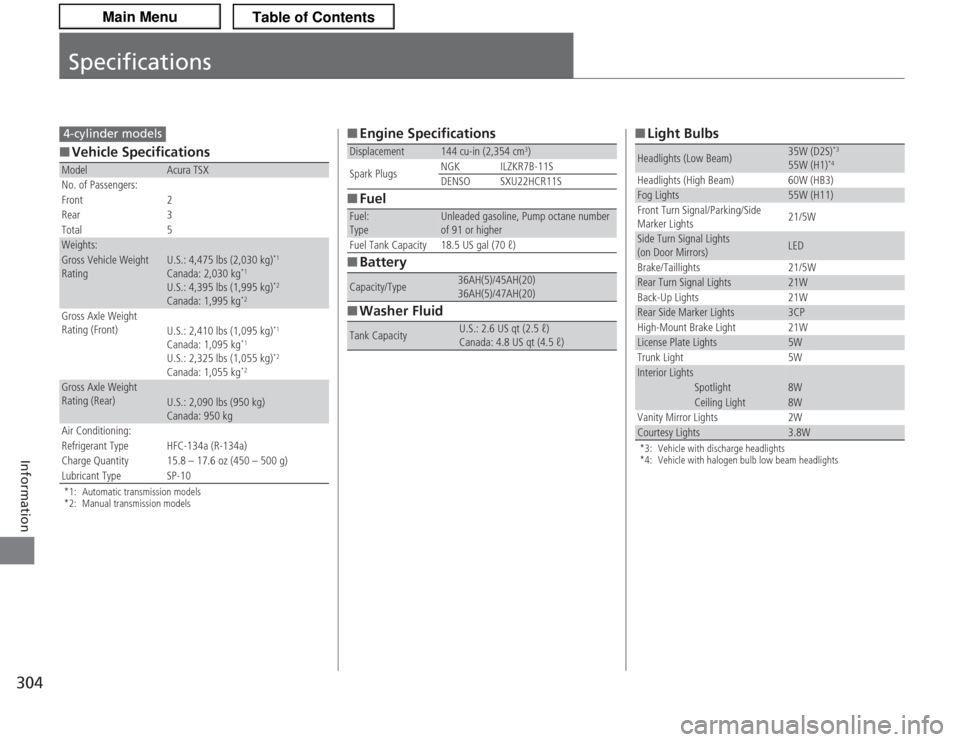
304Information
Specifications■Vehicle Specifications*1: Automatic transmission models
*2: Manual transmission modelsModel
Acura TSX
No. of Passengers:
Front 2
Rear 3
Total 5
Weights:Gross Vehicle Weight
Rating
U.S.: 4,475 lbs (2,030 kg)
*1
Canada: 2,030 kg
*1
U.S.: 4,395 lbs (1,995 kg)
*2
Canada: 1,995 kg
*2
Gross Axle Weight
Rating (Front)
U.S.: 2,410 lbs (1,095 kg)
*1
Canada: 1,095 kg
*1
U.S.: 2,325 lbs (1,055 kg)
*2
Canada: 1,055 kg
*2
Gross Axle Weight
Rating (Rear)
U.S.: 2,090 lbs (950 kg)
Canada: 950 kg
Air Conditioning:
Refrigerant Type HFC-134a (R-134a)
Charge Quantity 15.8 – 17.6 oz (450 – 500 g)
Lubricant Type SP-10
4-cylinder models
■ Engine Specifications
■ Fuel
■ Battery
■ Washer FluidDisplacement
144 cu-in (2,354 cm
3)
Spark Plugs NGK ILZKR7B-11S
DENSO SXU22HCR11S
Fuel:
Type
Unleaded gasoline, Pump octane number
of 91 or higher
Fuel Tank Capacity 18.5 US gal (70 ℓ)
Capacity/Type
36AH(5)/45AH(20)
36AH(5)/47AH(20)
Tank Capacity
U.S.: 2.6 US qt (2.5 ℓ)
Canada: 4.8 US qt (4.5 ℓ)
■ Light Bulbs*3: Vehicle with discharge headlights
*4: Vehicle with halogen bulb low beam headlightsHeadlights (Low Beam)
35W (D2S)
*3
55W (H1)
*4
Headlights (High Beam) 60W (HB3)Fog Lights
55W (H11)
Front Turn Signal/Parking/Side
Marker Lights 21/5W
Side Turn Signal Lights
(on Door Mirrors)
LED
Brake/Taillights 21/5W
Rear Turn Signal Lights
21W
Back-Up Lights 21W
Rear Side Marker Lights
3CP
High-Mount Brake Light 21W
License Plate Lights
5W
Trunk Light 5W
Interior Lights
Spotlight
8W
Ceiling Light
8W
Vanity Mirror Lights 2W
Courtesy Lights
3.8W
Page 307 of 325
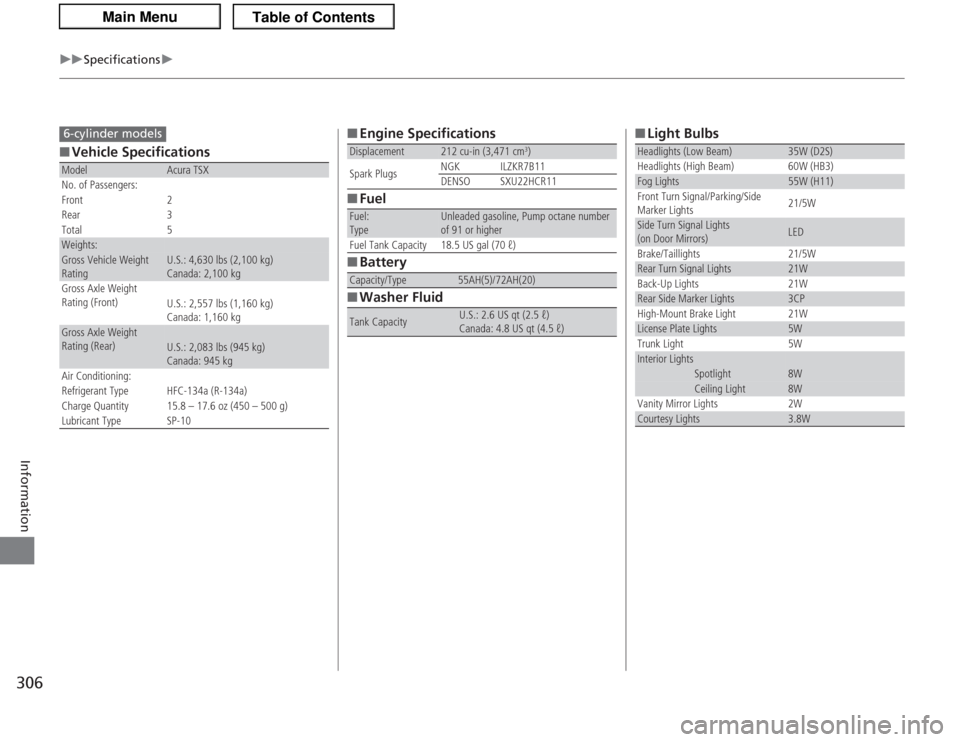
306
uuSpecifications u
Information
■Vehicle SpecificationsModel
Acura TSX
No. of Passengers:
Front 2
Rear 3
Total 5
Weights:Gross Vehicle Weight
Rating
U.S.: 4,630 lbs (2,100 kg)
Canada: 2,100 kg
Gross Axle Weight
Rating (Front)
U.S.: 2,557 lbs (1,160 kg)
Canada: 1,160 kg
Gross Axle Weight
Rating (Rear)
U.S.: 2,083 lbs (945 kg)
Canada: 945 kg
Air Conditioning:
Refrigerant Type HFC-134a (R-134a)
Charge Quantity 15.8 – 17.6 oz (450 – 500 g)
Lubricant Type SP-10
6-cylinder models
■ Engine Specifications
■ Fuel
■ Battery
■ Washer FluidDisplacement
212 cu-in (3,471 cm
3)
Spark Plugs NGK ILZKR7B11
DENSO SXU22HCR11
Fuel:
Type
Unleaded gasoline, Pump octane number
of 91 or higher
Fuel Tank Capacity 18.5 US gal (70 ℓ)
Capacity/Type
55AH(5)/72AH(20)
Tank Capacity
U.S.: 2.6 US qt (2.5 ℓ)
Canada: 4.8 US qt (4.5 ℓ)
■ Light BulbsHeadlights (Low Beam)
35W (D2S)
Headlights (High Beam) 60W (HB3)
Fog Lights
55W (H11)
Front Turn Signal/Parking/Side
Marker Lights 21/5W
Side Turn Signal Lights
(on Door Mirrors)
LED
Brake/Taillights 21/5W
Rear Turn Signal Lights
21W
Back-Up Lights 21W
Rear Side Marker Lights
3CP
High-Mount Brake Light 21W
License Plate Lights
5W
Trunk Light 5W
Interior Lights
Spotlight
8W
Ceiling Light
8W
Vanity Mirror Lights 2W
Courtesy Lights
3.8W
Page 322 of 325

321
Index
Number Tag.............................................. 90
Rear Door Won’t Open ............................. 94
Remote Transmitter .................................. 91
Retractable Master Keys ............................ 89
Types and Functions.................................. 89
Valet Key .................................................. 90
Won’t Turn ............................................... 17
Kickdown (Automatic Transmission) ...... 194
LLanguage (HFL)........................................ 178
LATCH (Child Seats) ................................... 53
Lights ................................................ 105, 247
Automatic............................................... 106
Bulb Replacement ................................... 247
Daytime Running Lights .......................... 107
Fog Lights ............................................... 107
High-Beam Indicator ................................. 69
Interior.................................................... 125
Light Switches......................................... 105
Lights On Indicator.................................... 69
Turn Signals ............................................ 105
Load Limits ............................................... 185
Locking/Unlocking ..................................... 89
Auto Door Lock/Unlock ............................. 94
Childproof Door Locks .............................. 94
From Inside ............................................... 93
From Outside ............................................ 91
Keys.......................................................... 89
Lockout Prevention System ....................... 92 Using a Key ............................................... 92
Lockout Prevention System ........................ 92
Low Battery Charge .................................. 290
Low Fuel Indicator ...................................... 66
Low Oil Pressure Indicator ................. 64, 290
Lower Anchors ............................................ 53
Lubricant Specifications Chart ......... 305, 307
Luggage (Maximum Load Limit) ............. 185
MMaintenance............................................. 221
Battery .................................................... 268
Brake/Clutch Fluid ................................... 244
Cleaning .................................................. 271
Climate Control ....................................... 270
Coolant ................................................... 240
Maintenance Minder
TM
............................ 225
Oil ........................................................... 235
Precautions .............................................. 222
Radiator .................................................. 241
Remote Transmitter ................................. 269
Replacing Light Bulbs ............................... 247
Safety ...................................................... 223
Service Items ........................................... 227
Tires ........................................................ 259
Transmission Fluid ................................... 242
Under the Hood ...................................... 229
Malfunction Indicator Lamp .............. 65, 291
Manual Transmission ................................ 199
Map Lights ................................................ 125 Maximum Load Limit
............................... 185
Meters, Gauges ........................................... 75
Mirrors ...................................................... 114
Adjusting ................................................ 114
Automatic Dimming ................................ 114
Door ....................................................... 114
Exterior ................................................... 114
Interior Rearview ..................................... 114
Modifications (and Accessories) .............. 219
Moonroof ................................................. 103
MP3 ................................................... 147, 153
Multi-Information Display ......................... 76
NNumbers (Identification).......................... 308OOdometer................................................... 77
Oil (Engine) ............................................... 234
Adding .................................................... 237
Checking................................................. 235
Displaying Oil Life .................................... 225
Low Oil Pressure Indicator ................. 64, 290
Recommended Engine Oil ....................... 234
Viscosity .................................................. 234
Opening/Closing Hood....................................................... 231
Moonroof ............................................... 103
Power Windows ...................................... 100